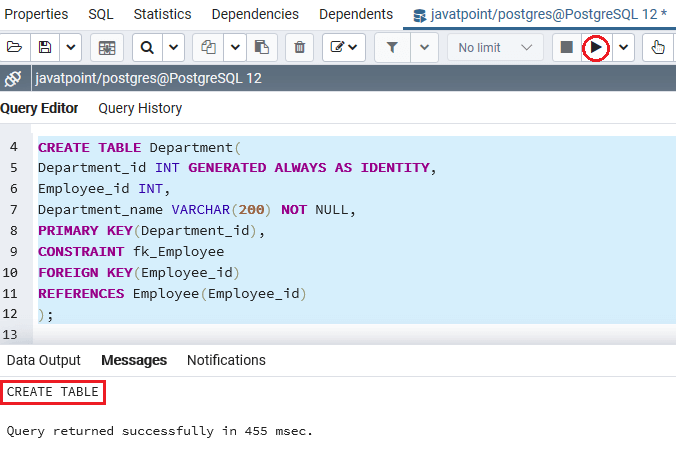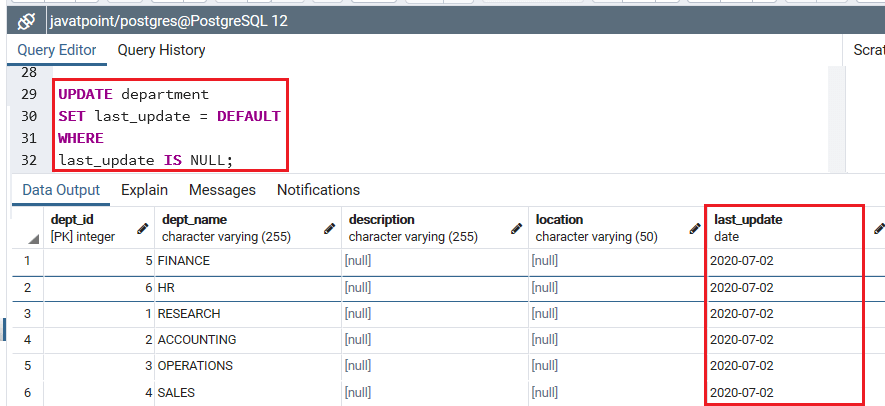
Let's further illustrate the difference with an example.

If you prefer to defer the check until the end of the transaction, use NO ACTION INITIALLY DEFERRED. NO ACTION is the default behavior if you do not specify anything. In practice, you can use either NO ACTION or RESTRICT depending on your needs. Just like RESTRICT, the database will not delete, update or set to NULL any rows in the referenced table(s). Otherwise if there are still rows referencing the parent row by the end of the transaction, an error will be raised just like before. If, for example there is another foreign key constraint between the same tables marked as CASCADE, the cascade will occur first and delete the referenced rows, and no error will be thrown by the deferred constraint. The difference from RESTRICT is that a constraint marked as NO ACTION INITIALLY DEFERRED is deferred until the end of the transaction, rather than running immediately. This will only raise the above error if the referenced rows still exist at the end of the transaction. However unlike RESTRICT, NO ACTION has the option defer the check using INITIALLY DEFERRED. If you set Cascading, they come along for the ride. A non-relational database like MySQL will just leave orphan foreign keys. When a foreign key constraint is defined with the option NO ACTION, it means that if a row in the parent table is deleted, the database will also raise an error and prevent the deletion of the row in the parent table. Baring a cascade rule, PostgresSQL will stop the update. The database will not delete, update or set to NULL any rows in the referenced table(s). When a foreign key constraint is defined with the option RESTRICT, it means that if a row in the parent table is deleted, the database will immediately raise an error and prevent the deletion of the row in the parent table. However, there is a subtle difference in how they behave. The difference between NO ACTION and RESTRICT is subtle and can be a bit confusing.īoth NO ACTION and RESTRICT are used to prevent deletion of a row in a parent table if there are related rows in a child table. This means that when a row is deleted from the "parent_table", all related rows in the "child_table" will be deleted as well. For example, the following SQL statement creates a foreign key constraint with the CASCADE option: These options can be specified when defining a foreign key constraint using the "ON DELETE" clause. This means that other cascading deletes can run first, and then this delete constraint will only throw an error if there is referenced data remaining at the end of the transaction. NO ACTION: This option is similar to RESTRICT, but it also has the option to be “deferred” to the end of a transaction.SET DEFAULT: When a row is deleted from the parent table, the values of the foreign key columns in the child table(s) are set to their default values.SET NULL: When a row is deleted from the parent table, the values of the foreign key columns in the child table(s) are set to NULL.RESTRICT: When a row is deleted from the parent table, the delete operation is aborted if there are any related rows in the child table(s).CASCADE: When a row is deleted from the parent table, all related rows in the child table(s) are deleted as well.Record that is associated with the deleted record in the OFFER table is also deleted.There are 5 options for foreign key constraint deletes: If a cascade-delete occurs in the production environment, any ORDERITEMS In the production environment, however, the cascade deleteĬan occur. Staging environment, deleting OFFER data in the staging environment does not have aĬascade effect within that environment. Since there is no transactional ORDERS data within the Delete any rows referencing the deleted row, or update the values of the.

The production environment, a cascade-delete operation might occur against records within ORDERITEMS table. pgAdmin - PostgreSQL Tools for Windows, Mac, Linux and the Web.

OFFER table is deleted in the staging environment and the deletion is propagated to When a record in a table that contains a cascade-delete foreign key relationship, such as the If you disable the mark for delete operation during a load process, the actualĭeletion of a record and subsequent cascade deletion of other records occur.

When a record is marked for delete, no cascade delete operation runs againstĪny database tables that have a foreign key relationship to the table that includes the record When you select to delete a record, most database records are marked for delete and not


 0 kommentar(er)
0 kommentar(er)
